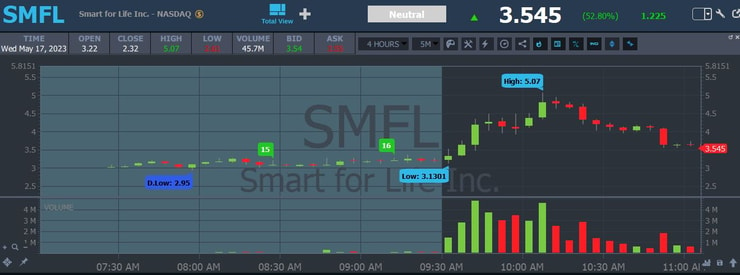There’s nowhere to run….
Nowhere to hide.
If you’ve got holes in your trading game, it’s just a matter of time until you’re exposed.
It’s our job to spot these holes and button them up if we want to be consistently profitable.
And while I’m trading better than last month, I still need to fix some stuff.
You may be dealing with the same issues or something else. Either way, I want to show you how I work through them, and hopefully, you can learn something from it.
The Good, The Bad, and The Ugly of Dip Buying

If you’ve been reading the blog, you know I’ve been favoring morning panic dip buys as one of my top strategies to trade.
But I need to be careful….
It’s like the saying: if all you have is a hammer, everything looks like a nail.
If I’m just looking for panic dip buys…then eventually, all sell-offs will look like dip buys.
And that’s sort of what happened to me on Wednesday.
Source: StocksToTrade
SMFL had a nice pop-off a PR stating it reached a deal with CloudKitchens for rapid local delivery of high-protein ice cream.
Not exactly a blockbuster headline…but the price action was strong. The stock hit a high of $5.07 in the morning, and I was waiting for a dip-buying opportunity to get in.
I got in at $3.60 and was looking for a quick scalp…which I got.
I exited at $3.72.
The stock pretty much traded downward after I closed it out.
I was happy with how I played this and happy I didn’t get greedy.
In fact, there was a lot of good for me to take back from this trade.
For example, focusing on risk and looking for entries that give me a chance to make money.
However, I also need to be careful.
Because a couple of hours after that trade, I made a boneheaded play in the ticker symbol XELA.
Source: StocksToTrade
XELA has been on a tear lately, going from $2.62 on Monday to a high of $8.85 on Wednesday.
But for whatever reason, I was not thinking about that when I decided to trade it.
In fact, I traded this in the afternoon. Normally, I like to take these plays in the morning.
So my timing was off.
But that’s not all.
I was also over-aggressive.
My entry was $7.12, not far from the highs. Not to mention, still significantly higher than the $2.62 it was trading at earlier in the week.
What does this mean in terms of the big picture?
Well, it means my timing has to be excellent.
And if it weren’t, I would be out of the trade for a fast loss.
The stock dropped below $7, and I bailed at $6.89.
What sucks is that the loss was double what I made on SMFL.
But there’s more.
The stock eventually did rally, but because my entry was poor, it would have been impossible to risk managing the trade responsibly.
That’s why waiting for a more meaningful panic is critical to executing the strategy.
Comparing The Two Trades
- SMFL was really the first-day mover… XELA has been a multi-day runner.
- SMFL is running on a PR…XELA is running on a short squeeze.
- The SMFL trade was earlier in the morning.
Bottom Line

Whenever I make a trading mistake, I want to dissect it and figure out what I’m doing wrong.
Mistakes cost money. So I want to fix them right away. In addition, I want to see what I’m doing correctly and figure out ways to replicate it.
If you’d like to learn more about my game-changing trading program, watch this.




Leave a reply